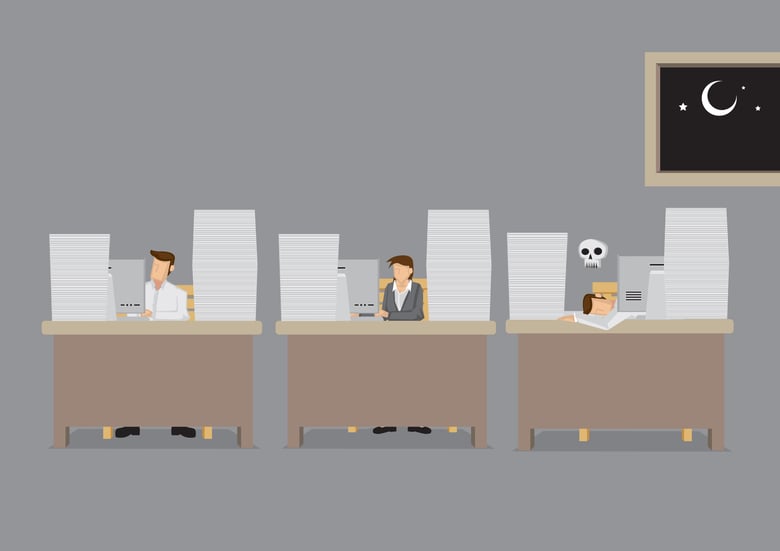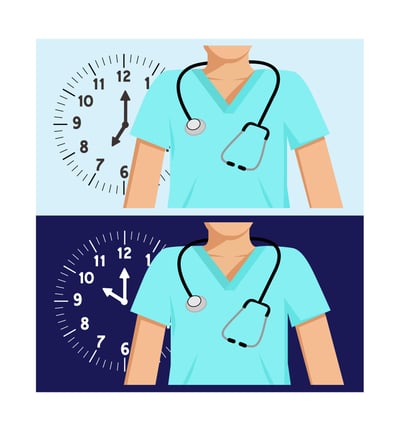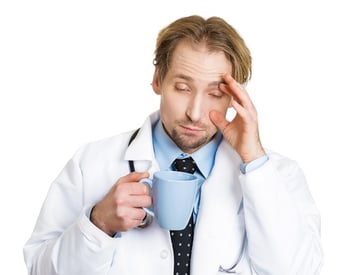 Shift work sleep disorder (SWSD) is a circadian rhythm sleep disorder caused by a person being awake during times when they naturally should be sleeping. SWSD is characterized by insomnia and excessive daytime sleepiness.
Shift work sleep disorder (SWSD) is a circadian rhythm sleep disorder caused by a person being awake during times when they naturally should be sleeping. SWSD is characterized by insomnia and excessive daytime sleepiness.
The human body needs 7 to 9 hours of sleep to function properly and thrive physically and mentally. Shift work disorder causes sufferers to get about 4 to 5 hours of sleep in a 24 hour period.
What is Shift Work?
 24/7. Companies love to boost that they provide services around the clock.
24/7. Companies love to boost that they provide services around the clock.
About 20% of the workforce work shifts other than the standard 9 to 5. Working the third shift, usually 11:00 p.m. to 7:00 a.m. (also known as the “graveyard shift”) can wreak havoc on an employee’s sleep and physical and mental functioning.
But it’s not just the graveyard shift that is considered shift work. Also included in the shift work classification is early-morning shifts that may begin at 4:00 a.m., night shifts which begin at 3:00 p.m., and rotating shifts which alternate day shift with night or overnight shifts.
Who is at Risk?
Not everyone who works an alternative shift suffers from shift work disorder. Some people love their alternative shift. People who are night owls have an easier time working a swing or graveyard shift than a morning lark person may have.
The timing of a particular work shift will affect when the person sleeps, eats and is active. Some shifts, like the graveyard shift, limit the amount of sleep or devastatingly affect sleep quality, causing increased stress on the body and more harmful effects.
What Causes Shift Work Sleep Disorder?
 Disturbances in sleep patterns are the hallmark of SWSD. These disturbances can range from not being able to sleep, to waking too early, to getting poor quality sleep.
Disturbances in sleep patterns are the hallmark of SWSD. These disturbances can range from not being able to sleep, to waking too early, to getting poor quality sleep.
The circadian rhythms of the human body cause the person to be alert during the day and to sleep at night. Shift workers operate on the opposite schedule.
Normally, the brain releases melatonin when it gets dark outside. Melatonin causes drowsiness and sleep. The morning sunlight causes the brain to be alert, and we stay alert (normally) until melatonin is again released.
What Else Happens When We Sleep?
Even after a few days of sleeping only 4 to 5 hours, wear and tear on the body will show. Lack of sleep causes alterations in glucose tolerance, preventing the glucose (which is fuel) to not be taken up into the cells effectively.
This sleep deprivation causes a decrease in leptin (an appetite-suppressing hormone) and an increase in ghrelin (a hormone that stimulates hunger). This hunger and fatigue makes one reach for food high in carbohydrates, salt and sugar. Oops! Putting on pounds. Obesity contributes to sleep apnea, another serous sleep disorder.
Studies also show that for people who sleep four hours a night (or day), cortisol levels were elevated before sleep and dropped six times slower than a person sleeping more than seven hours. This increased cortisol placed people at a higher risk for diabetes and obesity.
Studies have shown that people who slept less than 5 or 6 hours per night were twice as likely to develop diabetes.
Shift work and the resulting sleep deprivation adversely effects the immune system. The body cannot fight off “bugs” and invaders and as a result, a state of inflammation occurs.
According to Dr. David Marquis, inflammation causes an array of medical conditions, including pain, peripheral neuropathy, heart disease, stroke, migraines, thyroid issues, dental issues, and cancer.
Rotating Shifts
 Rotating shifts take different forms but they basically include switching back and forth between day shifts and night shifts, either within a short period of time (within the same week) or every few weeks.
Rotating shifts take different forms but they basically include switching back and forth between day shifts and night shifts, either within a short period of time (within the same week) or every few weeks.
It is more difficult to deal with rotating shifts than it is to work the same shift for a longer period of time.
In a study of 683 men, those working rotating shifts during the night and early morning had significantly lower levels of serotonin, a hormone which regulates sleep and is linked with anxiety, anger and depression.
Female nurses who worked rotating night shifts for five or more years had an increase in cardiovascular disease and all-cause mortality. Those who worked 15 or more years of rotating night shift appear to have an increase in lung cancer mortality as well.
Symptoms of SWSD
Humans' propensity to be awake during the day and to sleep at night is caused by the natural circadian rhythms in the brain. Graveyard shift workers may go to bed at 8:00 a.m. planning to sleep 8 hours but wake up at noon and be unable to fall back to sleep.
This lack of sleep causes many symptoms, some of which are listed here:
Insomnia
Lack of energy – fatigue
Difficulty concentrating
Headaches, especially cluster headaches
Irritability / bad mood
These symptoms can lead to increased short-term risks for
Microsleeps (falling asleep for a few seconds)
Accidents related to drowsy driving
Falling asleep at work
Workplace injuries and accidents
Costly mistakes at work
Increased use of sick time
Substance abuse and alcohol abuse
These short-term effects are bad enough, but the long-term effects of untreated shift work are very alarming:
Anxiety
Frequent infections, colds and flu
High cholesterol levels
GI disorders / digestive disease
Type II Diabetes
Epilepsy
Substance abuse
Reproductive disorders
Jobs with Higher Risks for Shift Work Disorder
Employees in certain jobs experience a higher risk for shift work disorder. Police officers, military employees, those in service industries, manufacturing, transportation, postal service, public safety, and health care personnel frequently work around the clock.
Medical Personnel
 Health care workers number more than 14 million employees, many of them working shift work hours.
Health care workers number more than 14 million employees, many of them working shift work hours.
Doctors, nurses and other health care providers are especially susceptible to shift work disorder.
In addition to working the second or third shift, medical staff frequently work longer shifts (12 hours or longer) on a regular basis or put in overtime. This adds additional stress to an already-overworked employee, making them prone to making mistakes which can be deadly.
According to Kathleen Michon, J.D., 1.5 million people in the U.S. each year are harmed by medication errors. This might occur by a physician prescribing the wrong medication, treating a misdiagnosed condition with the wrong medication, or a nurse or administrator giving the wrong medication or wrong dosage.
The administration of the wrong anesthesia or miscalculated dosage can result in permanent injury, brain damage or death, and surgical errors made by the surgeon or mistakes made by the nursing staff during post-op care can lead to further pain and suffering.
Truck Drivers
.jpg?width=350&name=shutterstock_282896849%20(1).jpg) Over-the-road truck drivers who drive through the night are especially vulnerable to getting drowsy and having accidents.
Over-the-road truck drivers who drive through the night are especially vulnerable to getting drowsy and having accidents.
Drowsy driving causes 1 out of every 5 fatal crashes – that’s 20 percent. Governors Highway Safety Association reported that in 2015 drowsy driving caused 328,000 crashes, 109,000 injuries, and 6,400 deaths.
Summary
Shift work is a necessary evil in an industrialized society like ours. From all-night grocery stores to factories to hospitals, employees work around the clock to provide services we need. Working a shift other than the day shift puts a strain on our bodies due to the misaligned circadian rhythms which keep the body functioning optimally. Sleep deprivation is a dangerous condition and is the cause of many of our society’s problems.
Sources:
www.sleepeducation.org
www.wikipedia.com
Delezie, et al. Interactions between metabolism and circadian clocks: reciprocal disturbances. Annals of the New York Academy of Sciences, 1243: 30–46.
FA Scheer, et al. Adverse metabolic and cardiovascular consequences of circadian misalignment. Proceedings of National Academy of Science. 106 (11): 4453–8. 2009.
Yong. Shift work and diabetes mellitus: a meta-analysis of observational studies. Occupational and Environmental Medicine. August 2014.
Parent, et al. Night Work and the Risk of Cancer Among Men. American Journal of Epidemiology. 176(9): 751–759. 2012.
Beck, et al. Management of cluster headache. American Family Physician.
71(4):717–724, 2005.
MV Vyas, et al. Shift work and vascular events: systematic review and meta-analysis. British Medical Journal. 26(345): July 2012.
KJ Navara, The dark side of light at night: physiological, epidemiological, and ecological consequences. Journal of Pineal Research, 43:215–224, 2007.
A Moore, et al. “Fatigue and Shift Work” ebook., Amazon.com.uk. February 2016.
Michon, Medical Malpractice: Common Errors by Doctors and Hospitals.
https://www.nolo.com/legal-encyclopedia/medical-malpractice-common-errors-doctors-hospitals-32289.html
Work on a Rotating Shift? Then You Probably Have Lower Levels of Serotonin, August 3, 2007. Hyyp://articles.mercola.com
Bennington. How Sleep Deprivation Fries Your Hormones, Your Immune System, and Your Brain. https://breakingmuscle.com/learn/how-sleep-deprivation-fries-your-hormones-your-immune-system-and-your-brain
Fangyi, et al. Total and Cause-Specific Mortality of U.S. Nurses Working Rotating Night Shifts. American Journal of Preventive Medicine. March 2015
Image Credit:
www.shutterstock.com









Leave a comment